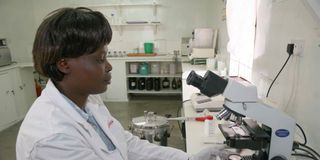Arrival of lethal mosquito puts Kenya under WHO spotlight

A laboratory technologist testing for malaria parasite in a specimen at Finlay flower farm clinic In Naivasha.
What you need to know:
- The report shows that the new mosquito vector, which Kenyan scientists reported earlier this year, had been detected in Marsabit County and is difficult to control compared to the existing ones.
- The vector has now spread to neighbouring Mandera County.
Kenya is one of the 10 countries on the radar of the World Health Organisation (WHO) for having a new mosquito vector called Anopheles stephensi whose introduction to the country is linked to climate change.
This is cited in the 2023 World Malaria Report which, for the first time, had a clause on climate change in the context of malaria transmission.
The new data shows that malaria cases are on an upward trend compared to previous years, with 16 million more people globally getting new malaria infections.
The report recorded an estimation of 249 million malaria cases in 2022 alone.
The report shows that the new mosquito vector, which Kenyan scientists reported earlier this year, had been detected in Marsabit County and is difficult to control compared to the existing ones.
The vector has now spread to neighbouring Mandera County.
“Anopheles stephensi quickly adapts to the local environment, surviving extremely high temperatures during the dry season when malaria transmission usually reaches a seasonal low,” explained the report which was released during COP28.
The report warns that the new species will be a threat to malaria control and elimination in Africa, the Arabian Peninsula, and southern Asia.
“If uncontrolled, its spread across Africa, combined with rapid and poorly planned urbanisation, may increase the risk of malaria transmission in African cities,” the report says.
WHO is asking countries to bolster their surveillance and demarcate the geographical spread of Anopheles stephensi using data to implement interventions.
“The potential direct effects of climate change on malaria could include expansion of its geographical limit, increases or reductions in transmission intensity within the current limits of transmission, reintroduction of malaria in areas where malaria was eliminated, or imperceptible changes in transmission,” stated the report.
Dr Tedros Adhanom Ghebreyesus, the WHO director-general, said in a statement that sustainable and resilient malaria responses are needed now more than ever, urging countries to take urgent actions to slow the pace of global warming and reduce its effects.
Dr Matshidiso Moeti, the WHO regional director for Africa, said that to forge ahead towards a malaria-free future, humans need efforts that foster innovation, resource mobilisation, and collaborative strategies.
“It is crucial to recognise the multitude of threats that impede our response efforts. Climate variability poses a substantial risk, but we must also contend with challenges such as limited healthcare access, ongoing conflicts and emergencies, the lingering effects of Covid-19 on service delivery, inadequate funding and uneven implementation of our core malaria interventions,” she said.
Speaking to Healthy Nation on the sidelines of COP28, Mr Martin Edlund, the chief executive for Malaria No More, said that despite the gloom around the new mosquito vector, there are some solutions that scientists are already coming up with.
One of the innovations he cited is a seasonal malaria chemoprevention which costs about Sh250 and is given to children every month, especially during the rainy season, preventing them from getting infected.
“We have seen about a 75 per cent decline in malaria cases among kids who received this. About 49 million kids currently have access to this innovation, mostly in the Sahel region and in West Africa. We are looking at how this can be expanded to places in East Africa,” he said Mr Edlund.
The new malaria report stresses the need for investment in malaria research in the wake of the climate crisis.
“We need research to show how climatic variations and climate change influence the malaria response across different timescales and effective ways to communicate these risks to policymakers, funders, and the public. Also needed is research into lowering the carbon footprint of the health sector, including the malaria response,” it stated.
With the Green Climate Fund being the biggest financial muscle for the United Nations Framework Convention on Climate Change, the report recommends that developed countries that are party to the convention jointly mobilise and operationalise the fund to have a section on malaria as part of mitigation finance strategies.
The report also highlights the need for a redesign of future healthcare products to make them more sustainable.
“Future products and their delivery will need to suit an operating environment that has been redefined by climate change – for example, medicines and diagnostics that are heat-stable and prevention tools that are suited for displaced or migrant populations. Their design should also minimise their environmental impact by identifying future products that are biodegradable, or that can be easily manufactured locally,” it states.





